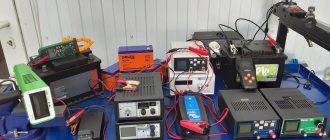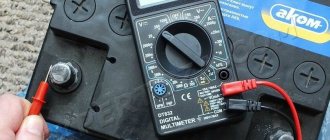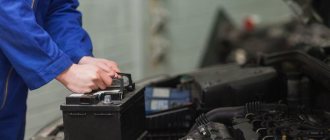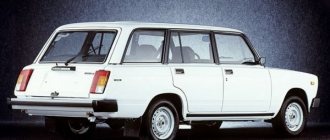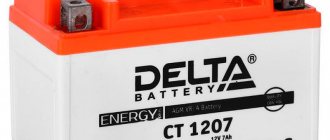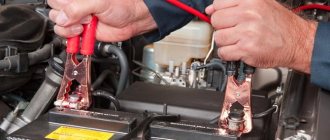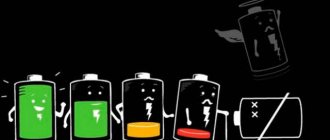Purpose of distilled water
Distilled water is an important component in the liquid of a car battery, ensures its full functionality, maintains the desired density of the electrolyte, which contains 65%. And the percentage of sulfuric acid is only 35%.
Sulfuric acid is a fairly highly concentrated chemical compound that, in its pure form, poses a danger to the battery. To reduce its concentration, purified water is needed. The ratio Н2О/H2SO4 = 65/35 ensures the accumulation of electrical energy at the time of charging the battery, which is subsequently used to start and move the vehicle.
Distilled water (DV) is ordinary water purified from organic compounds (waste products of plants and animals, bacteria, viruses) and inorganic impurities (salts, mineral additives, other substances). It consists of two chemical elements: hydrogen (H) and oxygen (O).
Before you find out how much distilled water to add to the battery, it is important to understand that ordinary water is not suitable for such a procedure. It contains a large number of different impurities (salts, chlorine, lime and others), which contribute to the rapid failure of the car battery. You cannot pour boiled water into the battery, since ordinary boiling does not distill (purify) the liquid in full.
Why is no electrolyte used?
During the operation of the battery, especially in the summer, the battery heats up, as a result of which the jars may boil. The DW evaporates at this moment. Acid is a non-volatile liquid; accordingly, it remains and the concentration of water decreases. The density of the mixture sometimes increases to 1.4 g/cm 3 . Therefore, in order to bring the electrolyte to normal density, it is necessary to add DV.
If you pour electrolyte, the density will decrease, but not enough.
It is important to remember about salt precipitation and destruction of the plates. Therefore, in order to reduce the density of the liquid to the established norm, only DV is added. This rule must always be remembered!
It is also worth remembering that water is added only to batteries of the type being serviced, which are characterized by maximum evaporation. Maintenance-free batteries are equipped with a molded sealed case; the evaporated liquid does not come out, it precipitates inside the can. In this case, a closed cycle occurs; there is no need to add water.
What can happen when opening the case?
If you open the battery case, this will lead to the fact that the water from the electrolyte will constantly evaporate and the battery will need to be refilled as if it were being serviced. Disassembling the battery in any way will void the warranty . For modern products, the manufacturer's warranty can range from 12 to 36 months.
Important! If the battery is under warranty, then before opening it and repairing it yourself, take it to a service center, maybe they can help you there.
Disassembling a battery is not always possible without chips getting into its housing. In addition, during operation of a battery opened in this way, dust and dirt may get inside the cans. Foreign objects inside the case, to put it mildly, do not contribute to increasing the service life of the product.
Do you have any questions, haven’t been able to solve the problem, or have something to add to the article? Then write to us about it in the comments. This will help make the material more complete and useful!
Modern power supplies for cars require less and less human participation during operation. Maintenance-free batteries do not need to be topped up with water or electrolyte throughout their entire operating life. If the owner likes the battery, but the indicator indicates that the resource is exhausted, is it possible to restore the battery? How to open the battery and get the lead plates for fishing?
When is battery refilling required?
Most experts believe that car batteries do not require maintenance. Accordingly, adding water to it is irrelevant, but provided that the battery is used under normal conditions. It is imperative to check the fluid level for motorists who travel long distances in their own cars. In this case, the probability of converting the liquid into a vapor state is greatest. And also the active process of water evaporation is carried out in the event of failure of the relay regulator.
Main indicators of failure of the relay regulator:
- during the operation of the vehicle, the battery becomes very hot;
- drops of electrolyte are observed on the battery body;
- Strong steam comes out of the filler necks.
It is necessary to take into account the design of the battery. In serviced models, much greater evaporation of H2O occurs. Therefore, it is for them that it is worth knowing how much water to add to the battery. In maintenance-free models, evaporation of liquid into the environment is prevented by a sealed cast housing. Such batteries do not require additional maintenance.
Checking the electrolyte level
The presence of electrolyte is checked exclusively in serviced batteries. They are most often equipped with a transparent body, so inspection is carried out visually. For this purpose, special marks are made on the surface corresponding to a certain volume of liquid.
Serviceable batteries with an opaque casing are also available. To determine to what level to add water to the battery in this case, the vehicle owner will need a special transparent tube with a diameter of 0.5 cm.
Fluid level check sequence:
- The battery cover is unscrewed;
- the transparent tube is lowered into the liquid, and it should rest against the bottom of the jar;
- its outer hole is clamped tightly with a finger;
- it is then removed from the battery to determine the electrolyte level.
Such a tube has minimum and maximum divisions. Accordingly, if the accumulated liquid is within these limits, the volume of electrolyte is normal. If the fluid is below the minimum, you need to add DV.
Safety when working with electrolyte
The electrolyte is a concentrated sulfuric acid solution that can cause burns to the body or cause serious injury if it gets into the eyes. Therefore, when working with it, be sure to take precautions:
- When performing any manipulations with the liquid environment of the battery, wear durable rubber gloves that do not have defects and goggles.
- Charge the device, top up, measure the level or replace the electrolyte composition only in a well-ventilated area or in the fresh air - acid fumes are dangerous to inhale.
- Always keep a container of clean water nearby so that you can quickly rinse the area where acid accidentally comes into contact with the skin.
How to add fluid correctly
If the density of the electrolyte in a car battery has increased or the battery does not provide the required voltage, then the reason is evaporation of the active substance. According to the norm, the electrolyte consists of: H2SO4 (sulfuric acid) - 35%; H2O - 65%.
Instructions for adding fluid to the battery:
- The upper surface of the battery is cleaned of dirt and thoroughly wiped, especially near the plugs.
- While charging the battery, sulfuric acid may have splashed out. Therefore, to neutralize it, the neck area must be wiped with a rag soaked in a soda solution.
- Now you need to carefully unscrew the plugs. It is recommended to wear gloves to protect your hands from the electrolyte.
- Using a medical syringe, DV is drawn up and poured into jars where the liquid level has dropped.
- The plugs are screwed in.
- After 2 hours, it is necessary to check compliance with the electrolyte density standards using a special device - a hydrometer. If the indicators are normal, the battery can be charged.
Add liquid only on a horizontal surface, otherwise the level will show the wrong volume. It is also worth considering the fact that the density of the electrolyte differs in different climatic conditions. For example, in Russia:
- in the south of the country - 1.25 g/cm3;
- in the central regions - 1.27 g/cm3;
- in the northern territories - 1.29 g/cm3.
To accurately measure the density of a liquid, the hydrometer must be strictly in a free state, in a vertical position and not in contact with the walls of the container. Having carefully lowered the hydrometer into the liquid, you need to wait until it completely stops oscillating, then take readings on the scale at the point of its intersection with the surface of the electrolyte. This is the density of the liquid.
What is an electrolyte
The battery is filled with a special liquid - almost every motorist knows this. It is precisely called an electrolyte. Liquid composition:
- sulfuric acid – 35%;
- distilled water – 65%.
Those. The mixture turns out the same. Therefore, the first rule when servicing batteries at home is accuracy. If a drop of electrolyte gets on your clothes, it will burn them and leave a burn on your body. Sulfuric acid after all.
Density
To put it as simply as possible, the density of an electrolyte is the percentage of sulfuric acid to distilled water. The normal value is 1.27-1.29 g/cm3. Using this indicator, you can determine the charge level and condition of the battery.
The density in jars is measured very simply - for this you need a device called a hydrometer. If your car battery is serviceable, you simply must have it in your arsenal. Especially when you consider how much the device costs. The price is 200-300 rubles, everyone can afford it.
Why is high or low density dangerous?
Is it possible to add electrolyte to the battery? It is possible, but only in extreme cases. If instead of water, you add pure electrolyte to the jars, the percentage of sulfuric acid will increase. As a result, the mixture will begin to corrode the lead plates. In general, its maximum density is 1.35 g/cm3. No more.
If we assume low density:
- capacity decreases;
- In severe frost, the battery may freeze.
Thus, you need to know what the density of the liquid in the jar is. Deviations from the norm will lead to irreversible consequences. A slight increase in density can be used if the battery is operated in severe frosts.
Obtaining distillate at home
There are motorists who do not go to the store for DV. They produce it themselves at home. This is mainly the older generation, who lived through times of shortage, and people living in settlements remote from the city, where many products simply do not arrive.
If you want to prepare DV yourself, you should understand that it will not be of high quality, since for this you need to have special expensive equipment - a distiller. But as an alternative, a regular moonshine still without a coil is suitable. The productivity of the DV when using this option will be approximately 1 glass in 3-4 hours.
The formula of distilled water is H2O. A high-quality liquid should not contain foreign impurities. It is impossible to achieve such a result under domestic conditions; a small content of metal salts will still remain.
Recommendations:
- If you urgently need to add water to the battery, you can take it from the tap into a plastic bottle and put it in the freezer for 2-3 hours. You should only use ice that has been melted beforehand. Unfrozen water is drained into the sink. The DV obtained in this way will cause minimal damage to the battery.
- Another way is to collect rainwater in a plastic container, carefully filter it, and then use it for its intended purpose.
Important! The collected water for the battery should not come into contact with iron objects. For example, water running off the metal roof of a house is not suitable for this purpose.
Owners of serviced car batteries need to regularly monitor the level of electrolyte in them and, if necessary, add pure H2O, free of minerals and organic additives. This water is called distilled and is an important component of the battery fluid. Its task is to maintain the chemical composition of the electrolyte at an optimal level, thereby guaranteeing high-quality battery operation.
Before you find out how to properly pour purified liquid into the battery, it is important to remember that it is prohibited to use tap or boiled water for this purpose. They contain a lot of foreign impurities (iron, calcium, magnesium, chlorine), which are deposited on the metal plates of the battery during charging. This “scale” leads to a decrease in battery capacity and destruction of its plates. This changes the density of the electrolyte in the battery.
Complete replacement of electrolyte in the battery
The electrolyte is a mixture of sulfuric acid and water in a certain proportion. The concentration of a solution is determined by the density measured by a hydrometer. The basic indicator, even hundredths, affects the ability of the electrolyte to work to store energy.
Signs of an unusable electrolyte:
- Measuring density on a charged battery with a hydrometer. The value should be 1.25 -1.27 g/cm3.
- A cloudy electrolyte is evidence that parasitic sulfation processes are taking place inside.
- The electrolyte froze, but the seal of the case was not broken.
- The solution is black or dark brown with a suspension of coal and scale.
Replacing the electrolyte in a battery will be effective when the cavities of the cans are examined, washed, and sulfate deposits are removed. If the plates are destroyed and the active substance has fallen off, the battery cannot be repaired.
At home, a complete replacement of the electrolyte in a car battery occurs in the following sequence:
- Prepare enamel or glass containers for draining the electrolyte, personal protective equipment, and a place to work, preferably outdoors.
- Remove the battery from the car, remove the plugs or drill holes in the maintenance-free battery, drain the liquid into a prepared container using a bulb or syringe.
- The battery is washed with distilled water several times until the sediment is removed. Lead sulfate may need to be removed if there is residue on the plates. You need to make sure that the active putty has not crumbled and that the coal grate is intact.
- Slowly, intermittently, pour the electrolyte of the required density into each jar 5-7 mm above the plates. Wait 2-3 hours for the bubbles to come out, measure the density of the electrolyte, bring it to normal
- After replacing the electrolyte, charge the battery with a low current of 0.1 A, avoiding boiling. After reaching half the capacity, charging is carried out cyclically.
- Seal the cans.
How long does it take to charge the battery? After replacing the electrolyte, you need to charge the battery carefully, as after a deep discharge. The operation of replacing the electrolyte with your own hands in a car battery is considered complete if it fully accepts current for a long time. Charging is carried out carefully; boiling in jars is unacceptable.
We invite you to watch a video on how to properly replace the electrolyte in a car battery.
This is interesting: Is it possible to use fog lights as daytime running lights?
Where can I get distilled water?
Car owners can buy deeply purified water in a five-liter bottle or other container at a hardware store, supermarket (in the household appliances department), pharmacy or at a gas station in the auto cosmetics department; these outlets are supplied by trusted suppliers. The largest manufacturer and supplier of distilled water is. You can order and buy distilled water on this page. You can also get it in normal home conditions, using one of the traditional methods of cleansing.
The first method is evaporation. For it you will need a large saucepan that closes tightly with a lid, a glass container and a metal grid. A wire rack is placed in the pan and then filled halfway with plain water. The glass container is placed on the grill so that its neck rises above the water. The pan is tightly closed with a lid and put on gas. Ice is placed on top of it. The water boils, condenses on the cooled lid and is collected in a glass container.
The second method is freezing. To do this, running water is poured into a plastic bottle and placed in the freezer. After half the liquid turns into ice, the unfrozen water is drained from the bottle and the remaining ice is melted. This is the distillate.
And the easiest way is to collect rainwater, which is a natural distillate. True, in large cities it has too high a percentage of acidic impurities, which makes it unsuitable for use in a battery.
Correctly pour distilled water into the car battery
The service life of the car battery and the serviceability of the car’s electrical network depend on how correctly we pour the distillate into the car’s battery. By maintaining the sequence of actions, we thereby extend the life of the battery.
1. Place the battery strictly horizontally. Otherwise, you will either overfill the water or not add it due to the fact that there will be different levels of liquid in the jars.
2. Wipe the surface of the battery around the edges of the plugs to remove any dirt.
3. Dip a rag in the soda solution and wipe the necks of the jars with it to neutralize the sulfuric acid that has accumulated there during the charging process.
4. Unscrew the caps, trying to prevent electrolyte from getting on your hands (it is better to wear gloves).
5. Fill a small rubber bulb with purified water and carefully pour it into each jar.
6. Inspect the electrolyte level in the jars - the battery fluid should be 1 cm above the top edge of the plates.
7. Simply remove excess liquid with a pear in the required volume.
8. Screw on the caps.
9. Charge the battery no earlier than after 3-4 hours.
In what volumes is electrolyte sold?
Now it’s not such a big problem to buy this liquid, you just need to sit down and go to a specialized store that sells batteries; it’s unlikely to be available in ordinary spare parts.
Basically it is sold only in two containers, these are 1 liter (bottle) and 5 liters (canister). If you were repairing, say, eliminating a short circuit, you only need to fill one jar, then 1 liter will be enough for you, as they say “for the eyes.” The cost ranges from 50 rubles for a liter bottle and up to 200 for five liters.
But if for some reason you need to change the entire volume, then it all depends on the size of your battery and its power.
How much distilled water should be added?
The batteries of new models, made of translucent plastic, are quite easy to add water to. On their body there is a scale with the manufacturer’s recommended liquid level, which must be adhered to. The situation is more complicated with older type batteries. Here are some tips to help you cope with the task. If your battery has a small tongue below the neck of the cans (metal or plastic), then water should be added until the electrolyte level rises 5 mm above it. If there is no tongue, then you need to add distilled water until the electrolyte level rises 1 cm above the top of the plates.
And a few more important points: do not add water to the car's autonomous power supply if you have just turned off the engine. The battery must sit for several hours before it can be opened. In the same way, you cannot immediately turn on the internal combustion engine after adding distilled water to the battery. The battery must sit for at least a few hours, otherwise it may boil.
An excellent alternative to distillate is deionized water. It is purer than distilled water, more precisely 100 times more pure, and can also be used for filling into batteries.
Distilled water for batteries
The battery is an integral part of almost any modern device or car. The battery, like all components of the car, requires care and compliance with recommendations during operation - one of the rules that must be followed is monitoring the level of distilled water in the battery.
It is required for the normal passage of all chemical processes occurring in the battery. When the level drops, you can fill the battery with distilled water yourself. How to do it yourself? How much should I add? How to track the level?
Determination of electrolytic fluid in a battery
There are two types of energy sources commonly used in the automotive industry today:
- Maintenance-free devices are enclosed in a sealed housing that completely prevents access from the outside. They, as a rule, exhaust their resource and must be replaced. You cannot restore their functionality on your own. The only thing the owner of such a battery can do is charge it as needed.
- Maintained - require constant attention and monitoring. It is necessary to regularly monitor the level of the electrolyte solution, as well as its density and the condition of the plates.
How to find out the electrolyte level
Electrolytic liquid can change its volume as it is stored and used. How can you check the electrolyte level in a battery? There are several options, each of which can be used in a specific situation:
- According to special marks applied to the body. Some energy sources have two horizontal lines parallel to each other on the outer surface of the housing in its upper part. The bottom one is marked “min” - shows the minimum possible level of the electrolyte solution. The top one has the inscription “max” - the maximum permissible limit of the liquid medium.
- By visual inspection. It allows you to determine the approximate amount of liquid content. In the absence of tags and other available means, it is enough to simply unscrew the plugs on the top cover of the case, while installing the device on a flat horizontal surface. Looking inside, especially if there is good lighting, you can understand by the following criteria whether the solution is enough or not:
- the plates are completely hidden by the liquid medium, there are no leaks on the outside of the case - the level is normal;
- the electrodes are visible (they are level or above the surface of the liquid) – topping up is required.
- By performing simple measurements. The electrolyte level in the battery can be checked using:
- Hydrometer device. It will allow you to find out the density of the liquid in each jar, which will make it possible to draw a conclusion about its quantity. We lower it into each hole one by one, draw up the solution using a bulb and look at the readings. If the value is higher than normal, then the level is insufficient.
- Available means: a transparent juice tube or the same body of a ballpoint pen. We lower the tube into the hole in place of the unscrewed cap until it rests against the top edge of the jar. We pinch the end remaining on the surface with a finger, thus blocking the flow of air into it. Holding your finger, remove the tube and measure the height of the column of liquid trapped inside it. At a normal electrolyte level, its value should be in the range from 11 to 15 mm.
Low battery electrolyte level
How can you tell if your battery has low electrolyte levels? This is very eloquently evidenced by:
- significant increase in density;
- the appearance of plates above the surface of the liquid medium.
There may be several reasons for this:
- Evaporation of distilled water is the most common factor in volume reduction in the summer. As is known, too high outdoor temperatures provoke evaporation processes. And when using the battery during this period, it is very hot under the hood.
- Liquid boiling over due to a malfunction of the temperature relay-regulator.
- As a result of battery discharge, some of the acid is consumed for electrochemical reactions.
A decrease in the electrolyte level below normal in the battery leads to very serious consequences:
- firstly, a solution of increased concentration promotes accelerated destruction of the plate material;
- secondly, that part of the electrode surface that is located above the liquid boundary undergoes sulfation.
In both cases, the outcome is the same: rapid loss of capacity and premature failure of the energy source. This means it will need to be replaced. Where is the guarantee that the new battery will not lose its functionality just as quickly?
Option one is to learn how to properly operate and maintain the battery, and first of all, maintain the liquid component at normal levels.
What should be the electrolyte level in the battery? The norm is when the electrolyte solution is 1–1.5 centimeters above the electrode plates, completely covering them when the car is moving. Moreover, the electrolyte level must be the same in each jar - this is very important for reliable battery operation.
How to fill
Serviced
Adding a little or pouring distilled water into the battery (being serviced) is not a problem, and it is possible to carry out the process yourself:
- You need to purchase distilled water (best at a pharmacy).
- The plugs are unscrewed so that the electrolyte and plates are visible - if the level of the mixture is below the plates, then it is necessary to fill in water with a syringe until the plates are closed (the level of electrolyte and water should exceed the plates by 1-1.5 cm).
- After adding, you need to charge the battery.
Maintenance-free
Is it possible to add distilled water to a maintenance-free battery? The answer is clear - it’s possible, but it’s more difficult to do than with the type of battery being serviced (the process is not provided by the manufacturer).
First of all, it should be noted that it is necessary to add water to a maintenance-free type battery much less frequently. This is due to the fact that batteries of this type are well sealed, and “ring technology” is used inside, which reduces evaporation to a minimum. The battery life without unnecessary manipulation is about 4-5 years.
Pouring process:
Adding distilled water to the battery
- It is necessary to determine the electrolyte level - to do this, shake the battery and determine the approximate level by sounds. When the feeling suggests that the level is normal, sulfation of the plates may have occurred and there is no point in adding water.
- It is necessary to determine the level of the plates - if the battery is not transparent, then you will have to determine it “by eye”; in other batteries you can illuminate it with a flashlight or buy batteries in a transparent case.
- An indentation is made from the plates by a maximum of 2 cm upwards, it is marked, and a hole is made with a drill (2-3 mm).
- Fill a syringe with distilled water and fill it until water begins to pour out of the hole made.
- The battery is shifted to the other side, and the holes made are sealed with a very ordinary soldering iron.
- Place it on charge and charge to full level.
The process is complex, and there are many inaccurate steps, but do not forget - the manufacturer does not provide for adding water to a maintenance-free battery!
Recommendations
- The surface on which the process takes place must be flat! For what? So that the mixture level is not distorted;
Distilled water for batteries
The process of pouring distilled water into the battery can be seen in the video.
Maintenance free battery
Now there are two battery designs, the so-called serviceable and maintenance-free . Their operating principle is similar, but the plates inside are slightly different:
For the “serviceable” ones , they are made with the addition of ANTIMONY (Sb), it is added for strength, but the downside is that the electrolysis process begins already at 12.7 - 13.0V. Accordingly, water in the jars is lost and must be constantly added. For this purpose, plugs are made on top
“Unattended” has no traffic jams at the top. Calcium (Ca) is also added to the plates of this battery, also for strength. The electrolysis process here is less obvious, and it appears only at 14.4 - 15V. That is, fluid loss is minimal. Therefore, the designers decided to remove the plugs from above
BUT, in my practice, moisture still leaves from maintenance-free batteries, but not as quickly as from ordinary ones, but after 5 - 7 years, the level can drop critically. The driver will think that it’s just time to change it, but it’s not. Just add “distillate”, charge the battery and the performance can be restored
Volume
How much distilled water should I add to the battery? What level is acceptable? It is necessary to top up until the plates disappear and are no longer visible. Translating the values into numbers, the amount of water depends on the total capacity of the battery, so you need to focus on hiding the plates with electrolyte by 1.5-2 cm. It is at this level that the required electrolyte density of 1.27 g/cm 3 is achieved.
Important: if, when adding water, the level is exceeded, the density will decrease, and there will be a possibility of the battery “freezing” in winter. When the level is exceeded, you can pump out the water using the syringe that was used to add it.
As a result, we can say that adding water to serviced batteries is an immediate necessity. The situation with maintenance-free batteries is different - it depends only on the wishes of the car owner. But in any case, you must remember that adding water is a temporary measure! After some time, it will still become unusable, and you will have to buy a new one.
Why is this ratio
Battery
Water can evaporate during operation, so it takes up more volume inside the battery. In order not to get into a situation where you need to add water, but there is no water at hand, it is recommended to carry distilled water with you (at least 1 liter).
Important: the level of distilled water in the battery must be higher than the plates (otherwise they risk overheating and falling off).
What is this as a percentage? Approximately 65% of the electrolyte mixture.


